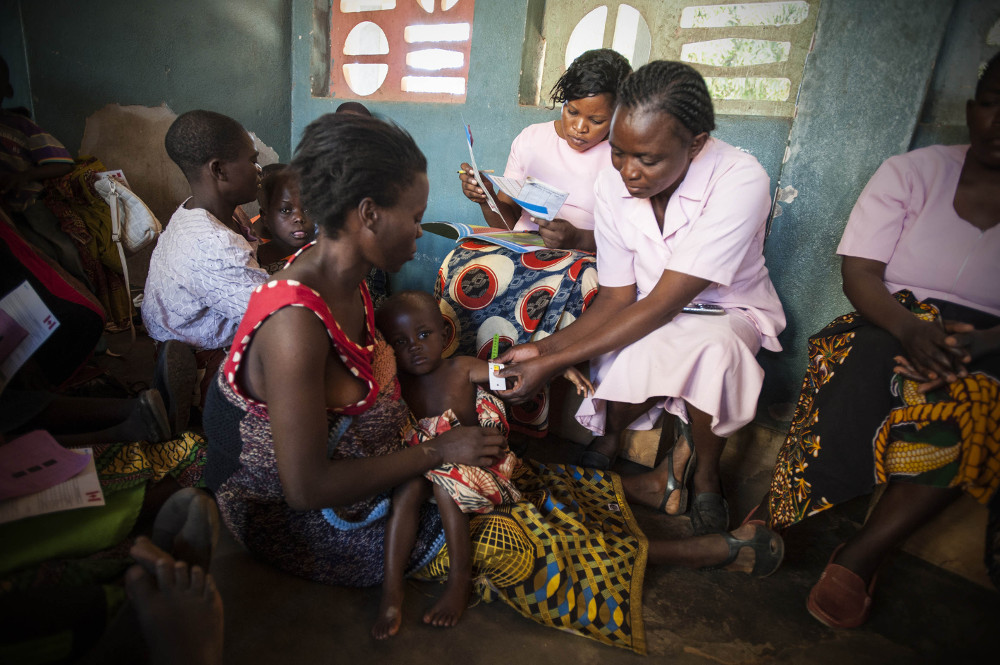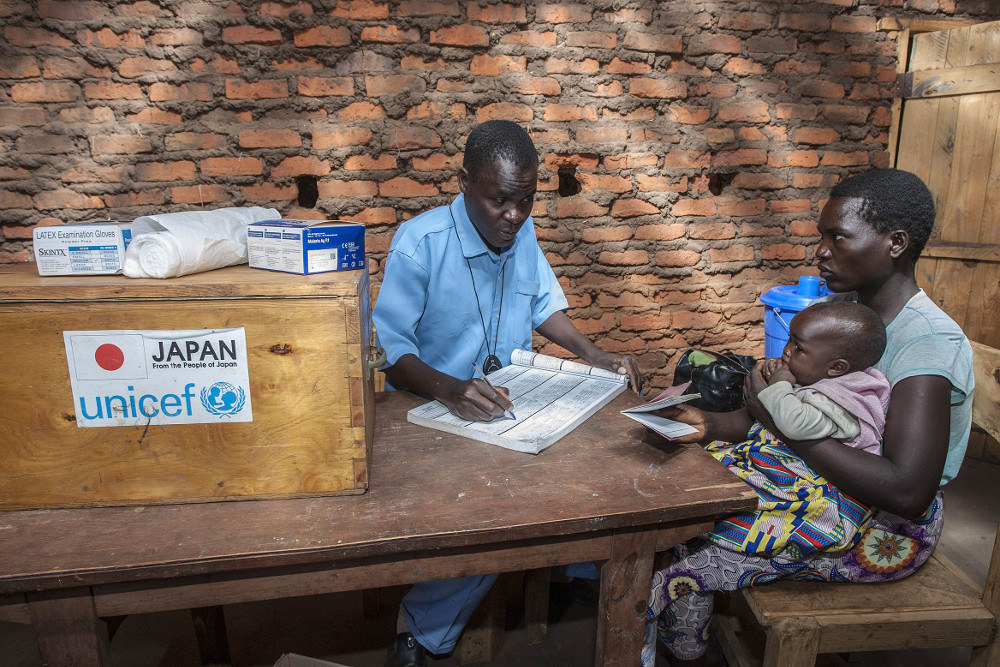High tech: Unicef tests a drone ahead of opening a corridor that will enable these devices to transport blood samples to and from the hard-to-reach rural Chanthunthu health clinic in Kasungu.
In remote villages hours away from Malawi’s cities, community health workers are saving the lives of small children in makeshift outdoor treatment areas.
Amidu Malope (37) sits under a tree with a wooden table by his knees. A malaria-testing device shows two bright lines running vertically down a screen. The lines mean that Malope’s previous patient — a four-year-old girl — was just diagnosed with malaria. A baby wriggles restlessly in her mother’s arms in front of him. They’re waiting to see whether this six-month-old will also test positive.
In this small village called Thipa, Malope is a bit of a hero — and he knows it. He volunteered as a community health worker in 2001 and when he realised that he could help people, he was inspired to go for further training. He finished school but has no tertiary education. Instead, the Malawian government provided general and then specialised primary care training for him to treat people. His patients are aged from neonatal to five years old.
“We were the first group of people doing drug distribution to people in the village. It made me think I could help people,” he says.
In Malawi, workers such as Malope are called health surveillance assistants (HSAs) and the United Nations Children’s Fund (Unicef), which provides supplies to these assistants, has said they are one of the reasons child mortality has dropped by two-thirds: from 244 deaths for every 1 000 live births in 1990 to 68 in 2015.

Alinafe brings her two-year-old daughter to be treated for severe malnutrition. Since the arrival of health surveillance assistants in remote areas of Malawi, the child mortality rate has dropped dramatically. (Sebastian Rich/Unicef)
The HSAs report to health service centres — small clinics dotted around the country. It is from the health service centre that Malope obtains supplies such as vaccines, medicines and testing devices. Through the HSAs’ work, which is recorded in large books handed to the healthcare centres, Malawi’s government can track which ailments most commonly affect children and how often they become ill.
Siyeni Phiri is familiar with the common diseases affecting children — she sees it in her daughter. Phiri has walked 5km from her village with her daughter, four-year-old Ruth, tied to her back. Ruth is tired, quiet and listless. Before Malope pricks her finger to take a blood sample for a malaria test, Ruth already knows what’s coming and begins to cry.
Her test is positive. In addition, she has pneumonia. Malope watches Ruth’s stomach rise and fall for one minute as she breathes. He counts 55 breaths — she’s breathing faster than the normal 40 breaths a minute. Malope makes the pneumonia diagnosis and gives her a chewable tablet called Coartem to treat the malaria. Her face grimaces at the taste.
In order to obtain the pneumonia medicine, the timer he wears round his neck, malaria pills and other necessities, Malope has to cycle 27km to the closest health centre. In rainy conditions, the terrain becomes even more difficult, meaning he has to spend more time away from the village clinic. He carries his load of supplies in a backpack. Vaccines that need to stay cold are kept in a cooler-box tied to his bicycle with a rope.
“In the rainy season, it can be difficult. The river overflows and when it does that, it becomes impossible. We can’t get to the health centre,” he says.
To do this taxing work, which in emergency cases takes longer than his working hours of 7.30am to 5pm, Malope is paid 72 000 Malawian kwacha by the Malawian government. That’s just R1 287 a month.
“It is not enough. Of course it isn’t, because we still have to support our families,” he says.
His story is not unusual in Malawi. Phiri grows maize. Since October 2016, she has harvested one tonne of maize but it will have to last her for the year. She has her doubts that it will last, and is relying on her brother to help her and her children.
Phiri was born in Malawi but moved to Zambia with her aunt. The aunt left her in a village and, before she knew it, Phiri was married at the age of 12. She thought being married would help her survive but after her husband violently beat her, family members in Zambia sent her back to Malawi, fearing he would kill her. She returned with six children.
“In Zambia, the clinics gave us family planning medicine [contraceptives], but my husband would take them away from me. When I went back to the clinic, they would tell me I can’t take more because I had collected contraceptives a few days earlier,” says Phiri.
She sits on a mat now, watching as Gladys Mwale and her six-month-old baby Judifi wait to see whether the infant’s malaria test will be positive. It’s negative, but Judifi still has to take medicine for pneumonia.
Mwale also married young — she is now 22 and has two children, the eldest aged three. She wants her children to have the education she could not have, but poor healthcare can affect education prospects too.
Chanthunthu Primary School, located further north in Chanthunthu village, is an extreme example of this. In order to get cellphone reception, head teacher Alick Phiri has to walk 200m from the school to make a call.
The school is for learners aged six to 18, but sometimes they have to go to the health surveillance assistant near the school for care. If the HSA isn’t there, the children have to walk 18km for medical help. The impact of this lack of access to healthcare on their education has been dire.
“There are so many stories. Just last week, there was a girl who was vomiting and had diarrhoea. She had to go home,” Malope said. “When the child is sick, they don’t get help at school.”
Teachers also stop children from writing exams or attending classes when they are ill. Pneumonia and diarrhoea — two of the most common illnesses in children in this part of Malawi — are contagious and put other children at risk if they are left untreated.

(Amos Gumulira/AFP)
The HSA nearby helps when he can but, as in Malope’s case, when it rains the river on the way to the nearest health centre overflows. The HSA normally has to travel 33km but in the rain he has to cycle around the river, lengthening his journey to 70km.
When Malope started out as a volunteer, he had no bicycle; once the government employed him, he could cycle for supplies. The Malawian government is now working with Unicef to open a corridor that will allow drones to deliver blood testing devices and provide internet connectivity to communities in need, such as Chanthunthu Primary School.
“It will help us a lot,” Malope says. “It will save us time to collect medicine. We can say it is a big relief to us.”
Like many other HSAs, he treats his patients under a tree. When the weather is bad, he is able to see patients inside the home of the chairperson of the village clinic. What makes Malope particularly proud is the way local communities have helped the HSAs. Every clinic is managed by a committee made up of community members, which is led by a chairperson. They communicate to the HSA how residents feel about their work.
The community is now building a structure for Malope so that he may have his own clinic.
“It helps us because they see this as theirs. That’s why they build structures for us. They see this clinic as their own,” he says.
There are 2 020 people in the village where he looks after children’s health. He sees each of them as being his responsibility. “I’ve helped a lot of people, I’ve saved a lot of people, so I feel proud,” says Malope.
This reporting was supported by Unicef